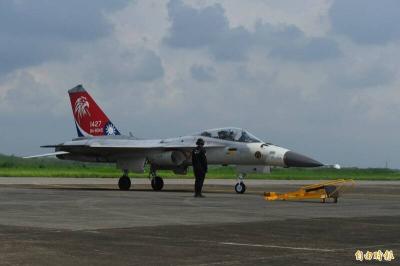Martial arts master and special forces combat trainer Liu Chang-i (劉長益) said he hopes to introduce the feeding crane style to the world as Taiwan’s distinctive martial arts form.
Liu, 55, has mastered the style and is a combat instructor for the army’s, marines’ and military police’s special service companies.
The companies last year jointly demonstrated their feeding crane-inspired hand-to-hand combat techniques at the Double Ten National Day ceremony, which Liu said made him proud.

Photo: Huang Hsu-lei, Taipei Times
The style’s emphasis on fast and deadly blows makes it suitable for military applications, where soldiers have to defeat the enemy quickly, Liu said.
“It was originally a fighting style for women. The point is to defeat the opponent immediately by using explosive power and striking at vital points, as women cannot win protracted struggles with men,” he said.
The style is said to have been created 400 years ago by Fang Qiniang (方七娘), who modified the Chinese white crane style for women’s self-defense, Liu said.
Fang’s system has four main traditions — the flying crane, singing crane, resting crane and feeding crane styles, the last of which was brought to Taiwan by Master Lin Te-shun (林德順) in 1927, he said.
Lin taught the feeding crane style to Liu’s grandfather and after that the title of the master passed from father to son, he said.
Learning the style at a young age, Liu said he began helping his father with teaching it from the age of 14 and started teaching his own classes when he was 21.
At the age of 32, Liu established a feeding crane style school in the US and he has since opened schools in Romania, Germany, Spain and France, he said, adding that he travels the world to teach the style.
Every Asian nation and culture around Taiwan has laid claim to a signature martial art, such as taichi, wing chun, karate, taekwondo, Muay Thai and escrima, he said.
“It is a shame that Taiwan does not have a representative martial art,” he said. “I want to leave behind something for the nation. I have vowed that I will travel to make the feeding crane style thrive all over the world,” he said.

LOW RISK: Most nations do not extradite people accused of political crimes, and the UN says extradition can only happen if the act is a crime in both countries, an official said China yesterday issued wanted notices for two Taiwanese influencers, accusing them of committing “separatist acts” by criticizing Beijing, amid broadening concerns over China’s state-directed transnational repression. The Quanzhou Public Security Bureau in a notice posted online said police are offering a reward of up to 25,000 yuan (US$3,523) for information that could contribute to the investigation or apprehension of pro-Taiwanese independence YouTuber Wen Tzu-yu (溫子渝),who is known as Pa Chiung (八炯) online, and rapper Chen Po-yuan (陳柏源). Wen and Chen are suspected of spreading content that supported secession from China, slandered Chinese policies that benefit Taiwanese and discrimination against Chinese spouses of

ALIGNED THINKING: Taiwan and Japan have a mutual interest in trade, culture and engineering, and can work together for stability, Cho Jung-tai said Taiwan and Japan are two like-minded countries willing to work together to form a “safety barrier” in the Indo-Pacific region, Premier Cho Jung-tai (卓榮泰) yesterday said at the opening ceremony of the 35th Taiwan-Japan Modern Engineering and Technology Symposium in Taipei. Taiwan and Japan are close geographically and closer emotionally, he added. Citing the overflowing of a barrier lake in the Mataian River (馬太鞍溪) in September, Cho said the submersible water level sensors given by Japan during the disaster helped Taiwan monitor the lake’s water levels more accurately. Japan also provided a lot of vaccines early in the outbreak of the COVID-19 pandemic,

PROMOTION: Travelers who want a free stopover must book their flights with designated travel agents, such as Lion Travel, Holiday Tours, Cola Tour and Life Tours Air Canada yesterday said it is offering Taiwanese travelers who are headed to North America free stopovers if they transit though airports in Japan and South Korea. The promotion was launched in response to a potential rise in demand for flights to North America in June and July next year, when the US, Canada and Mexico are scheduled to jointly host the FIFA World Cup, Air Canada said. Air Canada offers services to 13 of the 16 host cities of the tournament’s soccer games, including Toronto and Vancouver; Mexico City, Guadalajara and Monterrey in Mexico; Atlanta, Georgia; Boston; Dallas; Houston;

The US approved the possible sale to Taiwan of fighter jet spare and repair parts for US$330 million, the Pentagon said late yesterday, marking the first such potential transaction since US President Donald Trump took office in January. "The proposed sale will improve the recipient's capability to meet current and future threats by maintaining the operational readiness of the recipient's fleet of F-16, C-130," and other aircraft, the Pentagon said in a statement. Trump previously said that Chinese President Xi Jinping (習近平) has told him he would not invade Taiwan while the Republican leader is in office. The announcement of the possible arms